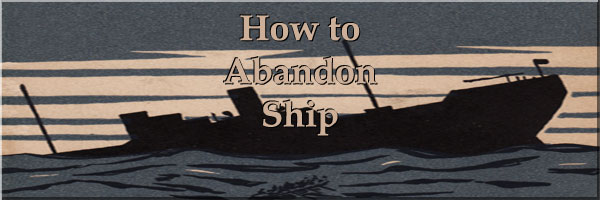
Chapter
In transporting troops the government works
on a wide margin of safety. Measures of precaution
are heaped upon one another. During the
last war four or five of the larger troopships
would be escorted by six or eight destroyers,
equal to three times as much protection per ship
as was given mercantile convoys.
More than 2,000,000 American soldiers were
transported to France without as casualty on the
eastbound trip. By June and July of 1918 about
300,000 U.S. troops a month were crossing the Atlantic.
This success was due in part to the fact that
the Germans were concentrating on merchant
shipping and homebound empties, and made
only a few feeble attempts against our troopships.
They did sink the U.S. transport President
Lincoln, but she was a westbound empty, and
only 26 persons were lost.
Despite all the measures of safety, U.S. troops
were killed on transports. The British Tuscania
was torpedoed in February 1918, and 213
American soldiers died. The Otranto was sunk
--68--
by collision, and 431 U.S. troops were killed.
The point to remember is that when transports
are hit, the loss of life is terrific: Arcadian,
279; Aragon, 610; Louvain, 224; Santa Anna,
638; Leasowe Castle, 101; Galway Castle, 189.
These figures should induce a soldier at sea to
be at all times vigilant and alert.
He should acquaint himself with every rule
and regulation regarding his own safety. He
must realize that the restrictions in area and
other regulations, absolutely unavoidable in
handling the mass, become an added hazard to
the individual's safety. He must understand that
in abandoning ship his superior officers are governed
by orders and regulations, and are not fortified
by experience. When a torpedo hits, the
government's wide margin for mass protection
becomes a narrow margin for individual error.
APPROXIMATE POSITION. -- You are to be
given the approximate position of the transport
at the time of abandoning ship. Without this
approximate position you will not be able to set
a course for the nearest point of land.
A transport's abandon-ship facilities are based
on the probability that the survivors will be
picked up within a short while. Since weather or
other conditions may prevent your immediate
rescue, you should make individual preparations
for your safety. Among these individual
--69--
precautionary measures should be the purchase at any
nautical store of six 10¢ Pilot Charts, covering
the entire world.
SILENCE. -- After the order is given to abandon
ship, keep quiet. No one is to talk except
those who are giving the orders or supervising
the execution of them.
OFFICERS. -- Non-commissioned officers are
not to leave the transport until all their men
have left. Commissioned officers must be the
last to leave the ship.
ORDERS. -- Do not obey any orders except
those given by the officers. Follow these orders
out as you were instructed during the drills. Be
sure that you do not misinterpret an order. Do
not forget that you alone -- by not knowing
what to do -- may be the cause of a panic.
QUARTERS. -- Since you will be assigned to a
certain section of the ship for the duration of the
trip, you must acquaint yourself with the alleyways,
companionways, and other means of escape
in your area. Be sure you know your alternative
if any of these exits are cut off. Use only
the alleyways and exits assigned to your unit.
During your recreation period study the details
of the ship's construction. Find the places
which will afford protection during shellfire
or bombing. Be sure you know the most direct
route to your raft or boat station.
--70--
UNDERCLOTHING. -- Said John J. Smith,
pumpman from a torpedoed tanker: "From now
on, winter or summer, the tropics or the arctic,
I'm wearing heavy woolen underwear."
Despite the discomfort, wear heavy underclothing
the entire voyage.
RATIONS. -- Though your boat or raft will be
supplied with rations, it is advisable to take
along extra rations. Concentrated food can be
carried in a large-sized money belt.
LIFE PRESERVERS. -- If your preserve is a cork
jacket, obtain a piece of nine thread or stout
cord to tie around it. This will keep the preserver
snug and low. It will lessen your difficulty
in going down a lifeline, and your head will not
be forced under water, which is one of the tricks
of these treacherous, high-riding jackets.
LIFEBOATS. -- Every other boat should be lowered
on each side, to reduce the possibility of one
boat being dropped on another.
LIFERAFTS. -- The rafts should be released one
after the other on both sides, beginning from the
after end of the ship. This will prevent the rafts
bunching up and will allow the men more freedom
of movement over a larger area.
LIFELINES. -- Do not jump overboard. Your
cork jacket will knock you out and cripple you.
It may cost your life. Use a line, net, or ladder.
LIST. -- The torpedoed transport Transylvania
--71--
was sunk in May 1917, with a loss of 269. A
slight list was corrected by massing the troops
on the high side, an example of the practical use
of moveable weight. Had the men gone over the
low side, greater losses would have been incurred.
SHELLFIRE. -- Should the enemy, by shellfire
or bombs, destroy the boat or raft to which you
have been assigned, do not attempt to crowd into
another boat or raft. Depend on your lifebelt for
the time being.
EXHAUSTION. -- Cold and exposure will hasten
exhaustion. An exhausted man should be transferred
to a lifeboat.
SHOCK. -- Have an understanding with the
men in your unit to watch one another for signs
of shock, which often works by delayed action.
Many men have perished in the water who could
have been saved with a little assistance during a
seizure or relapse. (Also see
page 94.)
--72--
Table of Contents
Previous Chapter (9) *
Next Chapter (11)
